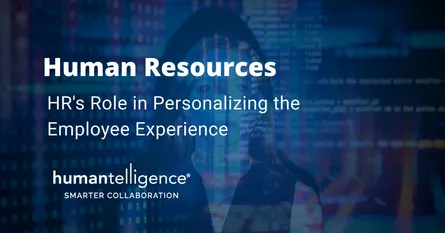
Intelligence

HR's Role in Personalizing the Employee Experience
- 01 May, 2024
- HR , Intelligence , Technology
Traditionally, HR departments have been the go-to touchpoint for talent acquisition, retention and growth, compliance, and benefits. Today, rapidly changing organizational needs and technologies—primarily AI and machine learning (ML)—are driving HR professionals to take on additional business-critical responsibilities, such as strategic workforce planning, optimizing the onboarding process, and personalizing the employee experience. To rise to this elevated role, HR leaders are unlocking new skills, including data literacy, technology expertise, talent optimization, and more. Taking these five key steps helps ensure your business doesn’t just keep pace with change, but also stays one step ahead of it. 1. Improve your data literacy Organizations collect more financial, workforce, and operational data than ever before. As a result, companies are starting to recognize the importance of breaking down data silos and making data more accessible to those who need it. When businesses democratize their data, they enable employees to deliver more actionable insights, lead organizational change, and drive growth. The ability of HR teams to intelligently interpret and act on that data will be what distinguishes their success rate. You might not find “data literacy” in many HR job descriptions, but it’s an increasingly important skill, ensuring that HR professionals can take advantage of the vast amounts of data available in the modern workplace. Peer-to-peer interactions are a great place to begin improving data literacy. HR leaders should collaborate with subject matter experts within the organization and consider data analytics training options. Investing time and resources in data literacy will pay off greatly in an increasingly data-driven climate. However, accessing and understanding data is just the first step. Next, HR professionals will have to practice storytelling—namely, translating data into actionable insights. To do so, you can expect to take on more robust analytics capabilities in order to connect data points to key business outcomes. For many businesses, this may initially appear like a seismic shift in approach, but if anything, it’s the opposite. The HR teams of the future are already using augmented analytics to deliver smarter story-based reporting, finding the human aspect behind the data. 2. Embrace AI and ML HR has shifted to a skills-based economy—and AI and ML are at the heart of that change. AI is not only essential for building a skills-based people strategy and personalizing the employee experience, but also for automating repetitive manual tasks and driving efficiencies across different company processes. In addition, solutions with natural language processing (NLP) can surface insights surrounding employee sentiment with greater clarity and precision. Any approach to HR that doesn’t take advantage of AI is destined to fail. When it comes to strategy, AI is already driving major changes in how HR teams function. AI can help to identify patterns across vast amounts of data that may otherwise be overlooked. By providing real-time analysis and automated recommendations, AI enables business leaders to pinpoint specific areas for improvement. The most forward-thinking organizations are already using AI- and ML-driven technologies to make more informed decisions and reduce friction across employee workflows. For many businesses, the prospect of integrating AI and ML technologies with an existing product suite can be daunting, which is why Humantelligence uses many of the employee communication tools you already have. AI represents an incredible opportunity to rethink the entire employee experience with new levels of insight and personalization. Over the next five years, AI will reshape how HR teams handle people management issues, predict future skills gaps, recommend career moves, and much more. 3. Take a strategic seat at the table Where HR was once viewed as a trusted partner, it is now looked to as a strategic leader. New technology increasingly relieves HR of repetitive manual tasks, leaving time for more forward-looking responsibilities. The time is now for HR to take on greater responsibility in leading organizations through the changing world of work. HR can now collaborate closely with business partners to:Understand and plan for current and future skills needs Create strategies to build, buy, or borrow requisite talent Provide managerial insight to boost team performance and productivityAn organization’s people can be its most valuable resource but also one of its most significant expenses. As a strategic business partner, HR has the opportunity to take the lead in managing people in new and innovative ways. With increased access to critical data, HR leaders can take a more commanding seat at the table, informing critical business decisions and driving key outcomes by drawing connections between talent and business performance. 4. Master skills-based talent development We’re in the midst of a fourth Industrial Revolution that’s being driven by increased connectivity and automation. As with any major industrial change, there’s been a dramatic shift around in-demand skills. Many skills are becoming obsolete at the same time that new skills are emerging, such as data science or social sourcing, creating a competition for talent. This new skills-based landscape puts HR in a unique position to enact major change. As in-demand skills are changing, so too are career paths. Workers are moving from full-time to part-time work across organizations, frequently shifting into different roles to build truly individualized careers. What once was linear is now circuitous or filled with many starts and stops. As organizations continue to seek out new skills, workers will continue to move laterally to acquire them. That’s where skills-based talent management comes in. By identifying which skills are already present within the organization, which skills are needed, and the strategies necessary to fill those skills gaps, HR will shape our organizational future. By adopting the idea that skills are a currency for jobs and careers, agile HR teams can lead skills-based planning to identify internal supply and demand and create internal development opportunities to cultivate the skills your organization needs most. It’s up to HR to tackle identified skills gaps, engage the current workforce, and use the appropriate AI and ML technologies to bring the organization up to speed. By identifying which skills are already present within the organization, which skills are needed, and the strategies necessary to fill those skills gaps, HR will shape our organizational future. By adopting the idea that skills are a currency for jobs and careers, agile HR teams can lead skills-based planning to identify internal supply and demand and create internal development opportunities to cultivate the skills your organization needs most. It’s up to HR to tackle identified skills gaps, engage the current workforce, and use the appropriate AI and ML technologies to bring the organization up to speed. 5. Strive for a frictionless employee experience Competition for talent is fierce, and your people are your competitive advantage. If you can’t explain what sets your organization apart from other employers, your organization is in trouble. Candidates’ and current employees’ expectations of employee experience are rising higher and higher—and we’re not talking ping pong tables and pizza parties. Employees want to join an organization that invests in its people. A major part of that is creating a frictionless employee experience. Often there is a discrepancy between the technology we use during our “9 to 5” versus during our “5 to 9.” Outside of work, people have the information and resources they need at their fingertips—now, they expect the same when it comes to their workplaces. When introducing new technology to your organization, ensure that it feels as engaging and intuitive as employees’ consumer apps. Personalizing the employee experience isn’t complete without measuring what’s working and what’s not. Keep a pulse on employee engagement with technology that surfaces sentiment insights in real time. Invest time ensuring your employees are engaged and identifying areas for improvement, and informing your employees of actions taken. By being transparent and proactive, you promote an employee experience that’s constantly evolving and improving. Find the right partner for personalizing the employee experience HR is facing constant industry and regulatory changes, shifting business needs, and emerging technology—but HR teams can turn these challenges into opportunities to drive value at their organization like never before. Honing the five key skills in this article won’t happen overnight, but you don’t have to do it alone. Humantelligence delivers technology that evolves as you do, with AI embedded at its core. With this tool integrated into your employee communication tools, you can:Boost employee engagement and team productivity Help team members collaborate more effectively Elevate and integrate enterprise learning into the flow of work Recruit and engage the right talent Personalize the employee experience Empower your employees and match them to the right opportunities Create effective talent and learning plans